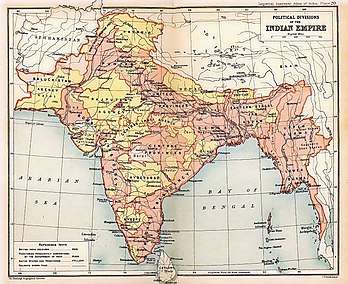Church of India, Burma and Ceylon
The Church of India, Burma and Ceylon (CIBC) was the autonomous ecclesiastical province of the Anglican Communion in British India.[3]
| Church of India, Burma and Ceylon (CIBC) Church of India, Pakistan, Burma and Ceylon (CIPBC) | |
|---|---|
_-_1865.jpg) St. Paul's Cathedral in Calcutta (1865) | |
| Classification | Anglican |
| Polity | Episcopal |
| Associations | Anglican Communion, World Council of Churches |
| Region | Indian Empire (1813-1947) North India & Pakistan (1947-1970) |
| Origin | 1813 |
| Separations | Church of South India (1947)[1] |
| Merged into | Church of North India (1970),[1] Church of Pakistan (1970)[1] |

The first Anglican diocese in India was established in 1813, the Diocese of Calcutta, which became the metropolitan see of the Church of India, Burma and Ceylon.[4] The Church of India, Burma and Ceylon spread as missionaries from the Church Mission Society travelled throughout the Indian Empire.[3] By 1930, the Church of India, Burma and Ceylon (CIBC) had fourteen dioceses across the Indian Empire.[2] Bishops from India were present at the first Lambeth Conference.[4]
After partition of India in 1947, the Church of India, Burma and Ceylon became known as the Church of India, Pakistan, Burma and Ceylon (CIPBC).[3] It published its own version of the Book of Common Prayer, which served as its authorised liturgical text.[1]
Later in 1947, four southern dioceses left the CIPBC and merged with South Indian Methodists and South Indian Presbyterians & Congregationalists to form the Church of South India.[1] In 1970, ecumenical dialogue led to the merger of the Church of India, Burma and Ceylon with other Protestant Christian denominations (including the Scottish Presbyterians, United Methodists and Lutherans), thus creating the Church of North India and Church of Pakistan.[4][3]
Dioceses
- Diocese of Calcutta (established in 1814)[2]
- Diocese of Madras (established in 1835)[2]
- Diocese of Bombay (established in 1837)[2]
- Diocese of Colombo (established in 1845)[2]
- Diocese of Lahore (established in 1877)[2]
- Diocese of Rangoon (established in 1877)[2]
- Diocese of Travancore (established in 1879)[2]
- Diocese of Chota Nagpur (established in 1890)[2]
- Diocese of Lucknow (established in 1893)[2]
- Diocese of Tinnevelly (established in 1896)[2]
- Diocese of Nagpur (established in 1903)[2]
- Diocese of Dornakal (established in 1912)[2]
- Diocese of Assam (established in 1915)[2]
- Diocese of Nasik (established in 1929)[2]
See also
- Christianity in India
- Christianity in Pakistan
- Christianity in Ceylon
- Christianity in Burma
References
- Buchanan, Colin (4 August 2009). The A to Z of Anglicanism. Scarecrow Press. p. 234. ISBN 9780810870086.
On 27 September 1947, after conversations and negotiations lasting 28 years, and in the teeth of Anglo-Catholic opposition throughout the Anglican Communion, the four southern dioceses of CIPBC left the Anglican church and joined with South Indian Methodists and the South India United Church (itself the result of an earlier union of Presbyterians and Congregationalists) to become the Church of South India. The CIPBC synod authorized its own Book of Common Prayer (fairly closely related to the 1662 Book) in 1960. Negotiations continued towards united churches, and they came to fruition with the formation of the Church of Pakistan on 1 November 1970 and the Church of North India on 29 November 1970.
- The Indian Year Book. Bennett, Coleman & Company. 1940. p. 455.
The three dioceses thus formed have been repeatedly subdivided, until in 1930 there were fourteen dioceses, the dates of their creation being as follows : Calcutta 1814; Madras 1835; Bombay 1837; Colombo 1845; Lahore 1877; Rangoon 1877; Travancore 1879; Chota Nagpur 1890; Lucknow 1893; Tinnevelly 1896; Nagpur 1903; Dornakal 1912; Assam 1915; Nasik 1929.
- Dalal, Roshen (18 April 2014). The Religions of India: A Concise Guide to Nine Major Faiths. Penguin Books Limited. p. 177. ISBN 9788184753967.
- Tovey, Phillip (30 August 2017). Anglican Baptismal Liturgies. Canterbury Press. p. 234. ISBN 9781786220202.
The formation of united churches, particularly that of North India in 1970, led to the end of the Province.